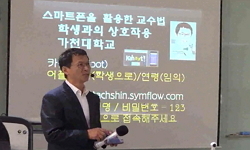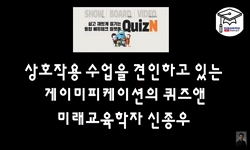본 연구는 표현예술심리치료가 만성 조현병 환자의 자기표현과 상호작용에 미치는 영향을 알아보고자 하는데 목적이 있다. 본 연구의 대상은 만성 조현병으로 DSM-Ⅳ에 의해 진단을 받고 정...
http://chineseinput.net/에서 pinyin(병음)방식으로 중국어를 변환할 수 있습니다.
변환된 중국어를 복사하여 사용하시면 됩니다.
- 中文 을 입력하시려면 zhongwen을 입력하시고 space를누르시면됩니다.
- 北京 을 입력하시려면 beijing을 입력하시고 space를 누르시면 됩니다.

집단표현예술심리치료가 만성조현병환자의 자기표현과 상호작용에 관한 연구 = A Case study of Self-Expression and Inter action of Patients with Chronic Schizophrenia through Expressive Group Arts Psychotherapy
한글로보기https://www.riss.kr/link?id=A109568854
- 저자
- 발행기관
- 학술지명
- 권호사항
-
발행연도
2016
-
작성언어
-
-
주제어
만성조현병 ; 자기표현 ; 상호작용 ; 사회복귀시설 ; 표현예술심리치료 ; Chronic Schizophrenia ; Self-Expression ; Interaction ; Arts Psychotherapy
-
등재정보
KCI등재후보
-
자료형태
학술저널
-
수록면
1-27(27쪽)
- 제공처
-
0
상세조회 -
0
다운로드
부가정보
국문 초록 (Abstract)
본 연구는 표현예술심리치료가 만성 조현병 환자의 자기표현과 상호작용에 미치는 영향을 알아보고자 하는데 목적이 있다. 본 연구의 대상은 만성 조현병으로 DSM-Ⅳ에 의해 진단을 받고 정신병원을 퇴원 후 사회복귀시설에 거주하면서 자기표현과 상호작용의 부족으로 대인관계에 어려움이 있는 대상 8명이다. 연구기간은 2013년 6월부터 9월까지 주 2회 60분씩 18회기를 진행하였다. 진행방법은 대인관계에 어려움이 있는 환자들의 심리적인 부분을 돕는 과정으로 초기, 중기, 후기, 종결단계를 통해 자기표현과 상호작용의 향상에 중점을 두고 프로그램을 진행 하였다. 본 연구의 평가방법으로는 혼합연구방법론을 적용하여 양적연구와 질적연구를 적용하였다. 양적연구를 위한 척도는 자기표현과 상호작용 변화를 알아보기 위하여 자기표현척도(Self-Directed Assertiveness Scale)와 대인관계척도(Relationship Chang Scale : RCS)를 사용하였고, 사전 · 사후의 변화를 분석하였다. 질적연구를 위하여 프로그램 진행시 집단원들과의 관계에서 나타나는 언어표현과 상호간의 행동과 작업을 녹음 및 기록, 사진자료를 중심으로 200여개의 코딩(coding)작업에서 도출된 주제가 감정표현, 의사표현, 자기개방의 ‘자기표현’, 친근감, 자신감의 ‘상호작용’, 상황파악, 계획세우기의 ‘현실인식’이라는 세 가지 범주로 요약할 수 있었다. 그리고 K-HTP(Kinetic-Drawing House, Tree, Person) 그림검사를 사전 · 사후를 실시하여 개인의 심리역동, 타인과의 상호작용 변화 분석을 하였다. 따라서 본 연구는 집단표현예술심리치료가 사회복귀시설을 이용하는 불안과 심리적으로 어려움이 있는 만성 조현병 환자들의 자기표현과 상호작용에 질적, 양적분석결과 긍정적인 영향을 주었다는 것을 알 수 있다.
다국어 초록 (Multilingual Abstract)
The purpose of the study was to examine the effects of self-expression and interaction of patients with chronic schizophrenia through expressive group arts psychotherapy. Participants of the study were the patients with chronic schizophrenia who being...
The purpose of the study was to examine the effects of self-expression and interaction of patients with chronic schizophrenia through expressive group arts psychotherapy. Participants of the study were the patients with chronic schizophrenia who being diagnosed by DSM-IV, the primary participants were eight patients who had difficulty in self-expression and interpersonal relationships due to lack of interactions while they were residing in a rehabilitation facility after discharging from a mental hospital. The period of the study was June to September of 2013, and the study were conducted with a total of 18 sessions for 60 minutes, and twice a week. The process of the study focused on improvement of self-expression and interactions by helping the patients who had difficulty in personal relationships and psychological problems through the process of the early, middle, late and termination stage. Evaluation method of the study used mixed methods of quantitative research and qualitative research. Self-Directed Assertiveness Scale (SDAS) and Relationship Change Scale (RCS) of examination of the interpersonal change were used for quantitative research by an analysis of before and after sessions. For the study of qualitative analysis, the researcher recoded 200 coding of expressive languages and behaviors through the relationships between group members during the process of the study. Through the process of recording, a research found three themes of ‘self-expression’ such as expression of feelings, expression of opinion, and self-disclosure, ‘interaction’ such as intimacy and confidence, and ‘awareness of reality’ such as awareness of situation and plan. The researcher analyzed an individual's psychological dynamics and changes of interactions with others through pretest and posttest of K-HTP (Kinetic-House, Tree, Person) drawings. The results of this study were as the following. First, according to the results of the differences between pre and posttest of self-expression through expressive group arts psychotherapy, a mean score of the pretest was 2.83 (SD = .83), and the mean score of the posttest was 3.63 (SD = .47). The result statistically showed significant difference (t = -3.97, p < .05). The results suggested that the expressive group arts psychotherapy helped the patients with chronic schizophrenia who have problems with self-expression by expressing their thoughts, desires and feelings appropriately through movement of body and media of arts. The expressive group arts psychotherapy provided positive effects on self-expression and interactions. Second, according to the results of the interpersonal differences between pre and posttest, a mean score of pretest was 3.23 (SD = .61), the mean score of posttest was 3.61 (SD = .41). The results statistically showed significant difference (t = -3.00, p < .05). The results suggested that the expressive group arts psychotherapy gave the patient a positive impact on mental health by providing positive interactions, supports, experiences and accomplishment. Third, the results of K-HTP drawing tests, an emotional state, desire, an individual psychological dynamics, and interactions with others showed positive changes on the results of pre and posttest. The results of the pretest of K-HTP drawings, the patients showed a negative themes such as an emotional anxiety, inner conflict, social disconnection and avoidance with interpersonal relationships, pathological fantasies and aggressive self-fulfillment. On the other hand, the results of the posttest, the patients showed an improvement of interpersonal relationships and the changes of self by awareness of the reality from delusion and fantasy by having an emotional stability and interaction. This results showed that the patients experienced positive effects on the expression and awareness of self through the expressive group arts psychotherapy. Finally, the results of the qualitative analysis through the process of expressive group arts psychotherapy, the study found three themes of ‘self-expression’ through expression of feelings, expression of opinion, and self-disclosure, ‘interaction’ through intimacy and confidence, and ‘awareness of reality’ through awareness of situation and plan. These results of expressive group arts psychotherapy coincided with Yalom’s therapeutic factors of group psychotherapy, which ‘self-expression’ coincide with ‘catharsis’, ‘interaction’ coincide with ‘installation of hope’ and ‘group cohesiveness’, and ‘awareness of reality’ coincide with ‘development of socializing techniques’ and interpersonal learning’. herefore, the results of the qualitative and quantitative analysis found that the expressive group arts psychotherapy showed positive effects on self expression and interaction of the patients with chronic schizophrenia who stayed in rehabilitation facility by providing an emotional stability for the patients who had difficulty in anxiety and psychological problems.
동일학술지(권/호) 다른 논문
-
집단 무용/동작 심리치료가 이혼으로 인한 한부모 가정 아동의 자아탄력성 증진에 미치는 영향
- 대한무용동작심리치료학회
- 김희선 ( Heesun Kim )
- 2016
- KCI등재후보
-
- 대한무용동작심리치료학회
- 남희경 ( Hee Kyung Nam )
- 2016
- KCI등재후보
-
주의산만한 ADHD경향 아동의 사회성에 미치는 동작촉진프로그램의 영향
- 대한무용동작심리치료학회
- 윤순희 ( Soonhee Yoon )
- 2016
- KCI등재후보




 KISS
KISS






